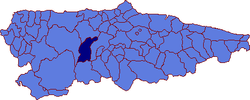This article needs additional citations for verification .(May 2024) |
Belmonte de Miranda Miranda | |
|---|---|
 | |
| Coordinates: 43°17′N6°14′W / 43.283°N 6.233°W | |
| Country | |
| Autonomous community | |
| Province | Asturias |
| Comarca | Oviedo |
| Judicial district | Grado |
| Capital | Belmonte |
| Government | |
| • Alcalde | Roberto Pérez López (PSOE) |
| Area | |
• Total | 208.01 km2 (80.31 sq mi) |
| Highest elevation | 1,527 m (5,010 ft) |
| Population (2024) [1] | |
• Total | 1,394 |
| • Density | 6.7/km2 (17/sq mi) |
| Demonym | belmontino/a |
| Time zone | UTC+1 (CET) |
| • Summer (DST) | UTC+2 (CEST) |
| Postal code | 33830 |
| Website | www |
Belmonte de Miranda (Asturian: Miranda) is a municipality in the Autonomous Community of the Principality of Asturias, Spain. It is bordered on the north by Salas, on the east by Grado, to the south by Somiedo and Teverga, and on the west by Tineo.


